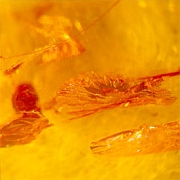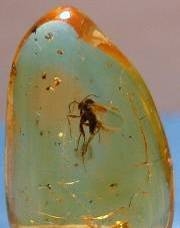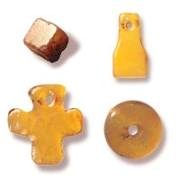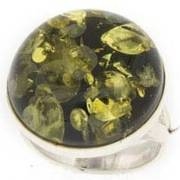It’s gone, Description Amber is fossilized pine tree resin. It ranges in color from deep, warm cognac to light honey to opaque, buttery yellow to rare shades of green. Amber often has inclusions that look like small reflective spangles. Baltic vs. Dominican Amber Today the two main sources of amber are the Baltic States and the Dominican Republic. Amber from the Baltic States is widely available since the opening of the economies of Eastern Europe and the former Soviet Union. The largest mine in the Baltic region is in Russia, west of Kaliningrad. Baltic amber occasionally washes up on the shores of the Baltic Sea as far away as Denmark, Norway and England. Baltic amber is older, but amber from the Dominican Republic is more likely to have insect inclusions. Amber prices can range from $20 to $40,000 or more, with older Baltic amber and amber with insect inclusions claiming the highest prices. History Insects in Amber and Dinosaurs Since the film Jurassic Park, amber with insects inside is in high demand. But could a mosquito trapped in amber really contain dinosaur DNA? Most amber isn't old enough, being no more than 50 million years old. The dinosaurs died out 65 million years ago at the end of the Cretaceous Period. Still, more than 1,000 extinct species of insects have been identified in amber and have helped paleontologists reconstruct early life on Earth. Stone Age Amber: “Burn Stone” Early civilizations imbued amber with supernatural properties. Stone Age amber artifacts have been found in Germany and Denmark. The ancient Germans burned amber as incense, calling the gemstone "burn stone." Roman Amber The Romans sent armies to conquer amber-producing regions. During the time of Roman Emperor Nero, a great connoisseur of amber, the price of a small amber figurine exceeded the price of a healthy slave. Medieval Amber During the Middle Ages, clear, colorless amber was considered the best material for rosary beads due to its smooth, silky feel. Until the year 1400, certain orders of knights controlled the amber trade and unauthorized possession of raw amber was illegal in most of Europe. Stradivarius Some have argued that the mysterious orange varnish of the infamous Stradivarius violin was made of amber that had been boiled in turpentine. The Amber Room In Russia, amber is thought of as the Gold of the North. In 1701, a palatial room was sumptuously decorated and completely paneled in a mosaic of priceless amber. This inexpressibly beautiful room was called the Eight Wonder of the World. As if foretelling of the Great Amber Room’s doomed destiny, the Amber Room was disassembled and changed hands many times. In 1755 it finally came to rest in the Catherine Palace near St Petersburg. After World War I, the walls were covered with cardboard, in an attempt hide the precious treasure from being seized by Nazis. Unfortunately in June of 1941, Hitler invaded Russia, and his soldiers plundered the Amber Room. A witness described what happened: Then I entered the Amber Room, where the walls were covered with thick cardboard. I saw two soldiers, keen to see what lay behind it, trying the tear down the protective covering...they raised their bayonets in an attempt to prize some mementos. Come the next day, the Amber Room had been ravaged. It’s gone, the Amber Room, the walls made of ‘sunstone’ have ceased to shine and only the sun that made them sparkle knows their fate, but the sun’s not saying. Victorian Amber Between 1895 and 1900, one million kilograms of Baltic amber were produced for jewelry. Folklore Amber: The Essence of the Sun Ancient Greek author Nicias wrote that amber was the essence of the setting sun congealed in the sea and cast up on the shore. Later Roman poet Ovid revealed the mythological origin of amber. Ovid wrote that Phaethon, a son of Helios, the god of the sun, convinced his father to allow him to drive the chariot of the sun through the heavens for a day. In his excitement, Phaethon drove too close to the Earth, scorching it. To save the Earth, Zeus struck his son with a thunderbolt. Phaethon died, plunging out of the sky. In their grief, his mother and sister turned into trees. Their tears, dried by the sun, were amber. The Greeks called amber elektron, meaning "sun-made." The word "electricity" also derives from the Greek word elektron, possibly owing to the fact that, when rubbed with a cloth, amber can attract dust and other small particles. Dreaming of Amber In Victorian times, dreaming of amber was thought to foretell a voyage. Symbolism Angel: Verchiel Planet: Sun Zodiac: Leo Countries: Germany, Romania and Sicily |
|






